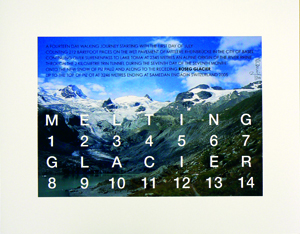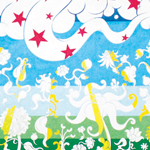Hamish Fulton at Rhona Hoffman Gallery
By Ania Szremski
Hamish Fulton is boring.

At least, that’s the impression conveyed by the current exhibition of Fulton’s works at the Rhona Hoffman gallery (October 29 – December 18). Large-scale vinyl text pieces, smaller inkjet prints, pencil and ink drawings, and shapes constructed from painted wooden sticks are the chilly interlocutors for a type of practice that, at the hands (or feet, as it were) of other artists, can inspire a profound sense of closeness. The story told by this exhibition, on the other hand, leaves the viewer feeling alienated and disinterested.
Since 1973, the London-born Fulton has been devoted to the art of walking, a type of practice perhaps better associated with the poetic and political meanderings of artists like Janet Cardiff and Francis Alÿs. The works on view at Rhona Hoffman bear highly abstracted testimony to the various paths the artist has trekked since the 1990s, both individually and in groups, through remote rural areas in Nepal, Japan, Spain, and elsewhere.
The walks tend to be long, grueling exercises, both physically and mentally, and at times the routes seem to have been chosen for their contentious socio-political connotations. But while the pieces displayed in the exhibition communicate basic information (indicating where, when, how many miles, how many people, and so forth), they in no way constitute documentary evidence of his journey.
Upon entering the gallery, for instance, the viewer is confronted with a floor-to-ceiling vinyl piece that declares in bold red and black letters: “Chinese economy/Tibetan history/eternal Kailash/Rangzen;” smaller, more modest text set in between those bold statements describes the walk itself: “Kailash Kora walking one circuit of the pilgrimage route round Mount Kailash/Tibet 5 + 6 October 2007 cold wind and sleet over the 5668 metre Drolma Pass/Following in the energy of a Buddhist nun.” The text is distributed as if aligned with an austere minimalist grid, formally reminiscent of something like Sol LeWitt’s “Red Square, White Letters;” or, perhaps, a very chic word search puzzle.
It’s this sort of work that leads to an alienating viewing experience. The text clues us in to the fact that Fulton’s walk was long and uncomfortable and politically charged. He was even kind enough to drive home the politics for us by printing the word Chinese in a nice, obvious red. But the actual experience of the walk itself is something jealously safeguarded for the artist alone. The wall of letters almost literally pushes the viewer away from any tangible understanding of the reality of walking down that pass; whatever Buddhist energy Fulton was following died long before it could cross the threshold of the gallery door. All the viewer gets is a perfunctory, sterile abstraction.
A few, significantly smaller pieces hang on the opposite wall, which are representative of the other type of work included in the show. Slender wooden sticks painted blue are affixed to the wall with long nails to form the silhouette of a child’s idea of a mountain range (three triangle tops); the artist scrawled on the sticks with pencil to provide the obligatory identifying information. Unlike the vinyl piece, the viewer has to come up close and engage carefully with the sculpture to take in the text (which is not to say that any greater degree of intimacy with the work is engendered).
Nearby, a photograph in the form of a glossy, small format, poster-like inkjet print reveals a generic view of a snow-capped mountain range. Text identifies the place, as well as the date and time the walk took place, and any other facts Fulton finds pertinent. The piece reads like a strangely obscure travel advertisement.
The viewer has to wonder where, exactly, the art is in this project. Fulton says that it’s in the experience of the walk itself. Since that can’t be embodied in an artwork, Fulton says, his texts and photographs are supposed to function like condensed signposts of his experience of being profoundly influenced by nature.
So if Fulton’s art is actually embodied in the experience of the walk, then what are we dealing with in the gallery? Conceptual abstractions that were made to sell, is the answer. And while Fulton did lead an artist walk through the city as part of the exhibition, if you missed it, then these chilly commodities are all you’re left with.

Of course, the problem of how to deal with performative art in the confines of a gallery is a persistent one, but other artists with similar practices handle it better than Fulton does. Richard Long, an English artist who started doing artist walks in the 60s, is a paradigmatic example. In fact, some of Fulton’s work almost looks like a poor imitation of his contemporary, except for the fact that Long actually altered the landscapes that he walked through (Fulton puts emphasis on the fact that he doesn’t).
There are also those more contemporary artists like Janet Cardiff and Francis Alÿs, who owe a debt to the Paris-based International Situationists. This group of artists-ideologues-activists from the 1950s famously drifted without aim through the streets of the city in an attempt to create a new, emotional relationship with the urban context. It was a utopian project, intended to radically reorient lived existence as free from the chains of capital. Cardiff and Alÿs’ walks richly evoke the social and political dimensions of the Situationists International, and they communicate their projects to the viewer in a way that is aesthetically compelling, socially relevant, and affectively powerful.
Closer to home, local artist and SAIC alum Amira Hanafi has a similar practice, which is also far more impactful than Fulton’s. She’s led poetic meanderings from Chicago to Cairo, encouraging participants to have a heightened awareness of their experience of walking, and to let go of the anxiety of having to go somewhere, or of trying to achieve something in particular. She exhibits the results as a compendium of personal photographs, poetic video clips and abstract written responses, which as a whole give the impression of a homemade scrap book. And while Hanafi’s work can err on the side of the touchy-feely therapy session, at least it’s a concerted attempt to reinsert feeling and community into what’s often described as the alienating contemporary urban experience.
Fulton has claimed that his work is about something similar: “My art is a passive protest against urban societies that alienate people from the world of nature,” he says. But it doesn’t work. His art lacks solvency, lacks relevance, and lacks a meaningful affective impact. In a word, it lacks interest. It is simply boring.
Hamish Fulton
October 29 – December 18, 2010
Rhona Hoffman Gallery
118 N Peoria







